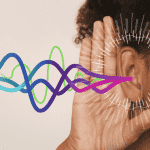Did you know that earwax is a good thing for your ears? Most folks don’t even know that earwax can help prevent bugs from entering into their ear canals. However, too much, too little, or a particular type of earwax could lead to problems for ears and hearing. Read more about what to do when earwax could become problematic.
What is Earwax?
Earwax or cerumen is a sticky, wax-like substance located in the ear canal. Earwax is not made of wax, like candle wax, but a combination of renewed skin cells, body secretions made of fat (also called sebum), dirt, and sweat. Earwax continues to reproduce more dead skin cells and sebum from the sebaceous glands, eventually producing earwax throughout time. The sebaceous glands produce the wax to help keep the ear canals moist and lubricated for comfort.
Earwax also helps trap any dirt or debris from entering further into the ear canal. When moving the jaw by talking or chewing, it can help “push” the excessive earwax from the back of the ear canal to the ear canal opening at the exit point. Fun fact: earwax does help ward off bugs from going further into the ear canal as well!
Is too much or too little earwax a good thing? Not necessarily. Although earwax has many advantages in protecting the ear canals and keeping them moist and comfortable, too much or too little earwax tends to be problematic. Abnormal looking earwax can also be problematic. Here are four things you need to know about when earwax becomes a serious problem.
Too much earwax may cause temporary hearing loss
When excessive earwax occurs, it could cause blockage in the ear canal. That blockage can give you a sensation of a hearing loss because sounds are unable to travel adequately to the organ of hearing. If you noticed that certain sounds are not clear or you feel that you are struggling to hear at times, you might have excessive blockage of earwax. If you also notice your ears feel full or get ringing in the ears (tinnitus), you may have excessive blockage of wax in the ears.
Do not use any objects such as a cotton swab to remove wax from the ears. Doing so could cause the wax to be pushed back further into the ear canal, resulting in more problems.
It is essential to have your ears evaluated and cleaned by your ENT physician or an audiologist. Removing the blockage of wax could help restore your sense of hearing back to its normal sensitivity. It doesn’t hurt to double-check your hearing sensitivity, though. Just ask to have a hearing test done.
Too much earwax could lead to ear infections
Earwax has a natural antimicrobial, meaning it can help prevent bacterial infections in your ear canals. If you feel you have excessive earwax and didn’t get it treated, excessive earwax could lead to an ear infection known as externa otitis. Without treatment, bacteria or fungus can grow among the earwax and could cause excessive itching, swelling, redness, pain, drainage or discomfort.
If your ears feel uncomfortable, itchy, or you notice an odd smell coming from your ears, see your ENT physician for an evaluation and treatment of a possible ear infection.
Lack of earwax can cause dryness
Some people do not produce enough earwax, which could lead to dryness of the skin inside the ear canals. Production of dry, flaky skin in the ear canal can result in a skin condition called dermatitis or eczema.
Dry skin conditions could result in constant itching and irritation of the ear canals. There are treatments to help alleviate dry skin canals. It is recommended to see your ENT physician for the treatment of dermatitis.
Particular color of earwax could indicate problems
Different color earwax could indicate the health of your ears. For example, dark-colored earwax means the earwax is old and ready to be removed from the ears. Light or medium brown colored earwax indicates the earwax is healthy and produces the right amount of earwax to keep the ear canals lubricated. White-colored type of earwax is an indication that there is a possible infection inside the ear canal (sometimes followed by an odd odor).
See the ENT physician to have your earwax checked to ensure there is no infection.
Outlook
Overall, having some earwax is a good thing as it acts as a protective barrier against dirt and keeps the ear canals moist and comfortable. Keep in mind that too little or too much earwax is not a good thing, especially if it’s producing odd colors or causes irritation, itchiness, or temporary hearing loss. It is highly recommended to see your ENT physician or your audiologist for the treatment of excessive earwax or dry skin in the ear canals.




